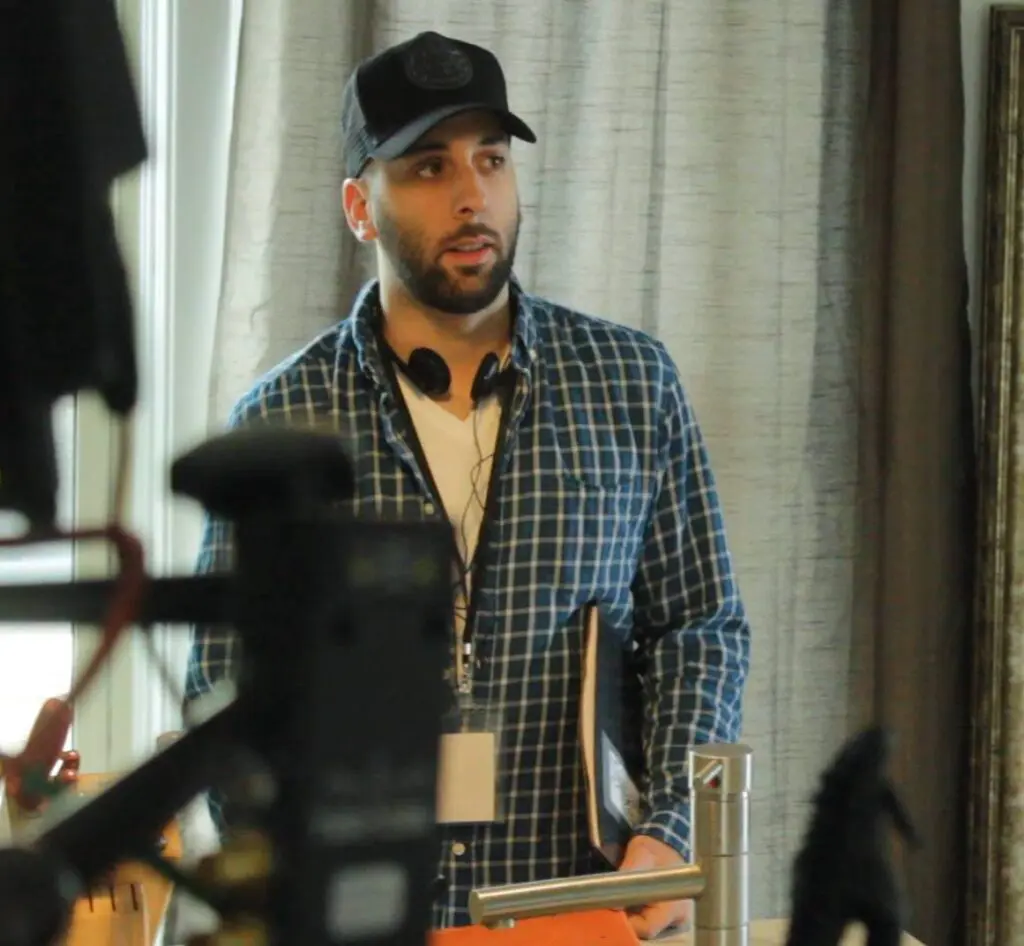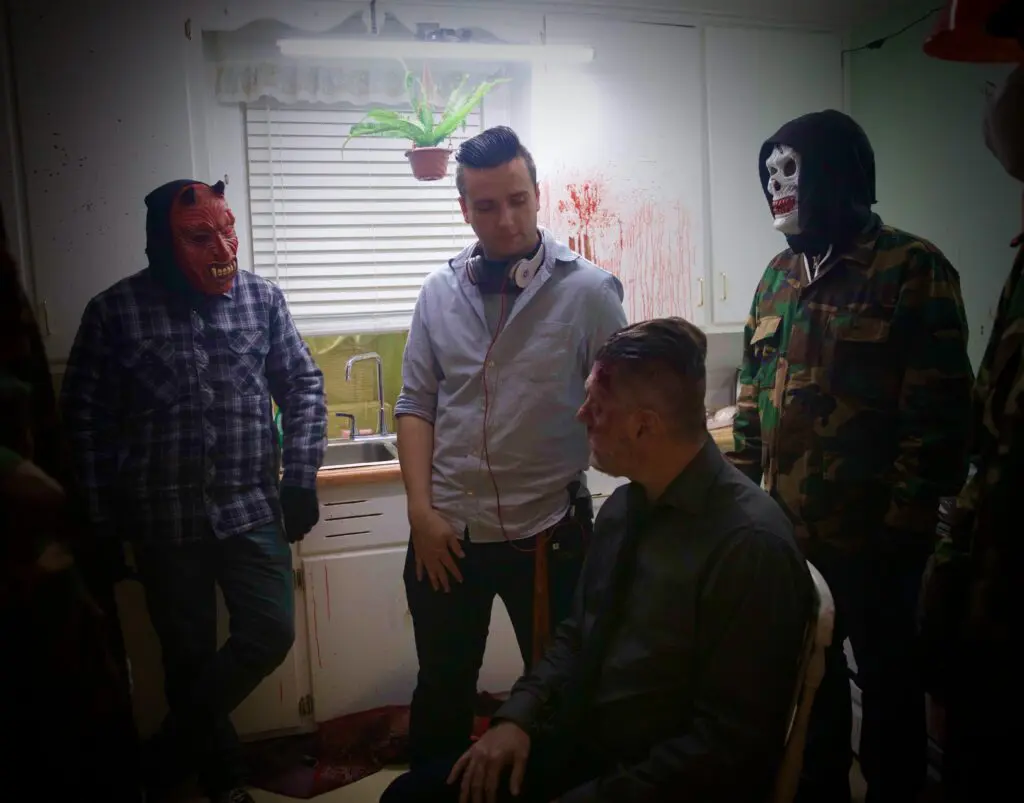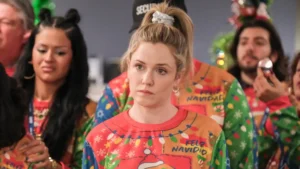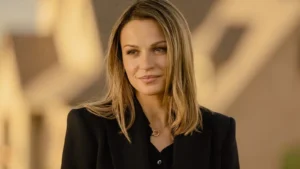Last night, I had the opportunity to talk to Reese Eveneshen and Gabriel Carrer, writers and directors of For the Sake of Vicious, a tense and bloody thriller with plenty of action. It had its UK premiere at FrightFest earlier this year and is now about to reach the north of England via Grimmfest’s Xmas Horror Nights. Reese and Gabe were a very approachable and unassuming pair to talk to, clearly pleased with their film and surprised by its success at festivals so far. We broke a little ice by talking about the other films in the programme For the Sake of Vicious was about to share, and then I jumped in: could they explain the title of the film?
Gabe responded: “I’m a fan of films with long titles, titles that feel like there’s a story behind them. You see a lot of horror films, films in general even, that have just short snappy titles. On VOD streaming, you need to have the title of the film visible to people. Texas Chainsaw Massacre, The Hills Have Eyes, The Day of the Dead: those have some substance to them. We both are fans of titles like these.”
Reese continued: “There were too many micro-titles that just didn’t seem to fit. The one word which we kept going to was ‘vicious’, because, you know, it is. Maybe we could call it a vicious cycle, or something like that, but it sounded too light. We bounced it around, along with a list, including Gabe’s For the Sake of Vicious and we kept that.”
Gabe added: “It’s a title that’s like saying ‘for the sake of it’. We were both going through some angry stuff. Why make this film? Just for the sake of it. So it came together.”
“And hey,” says Reese “people have been talking about it!”
I returned to Gabe’s comment about the anger: was it a cathartic outlet? “Well yeah, for both of us. We come from a small city, where we’ve known each other for over ten years and you know we’ve made movies for so long and find ourselves wondering: should I be going out partying more? Drinking more? Should I be out socializing to get funding? I don’t brown-nose or kiss ass, anything like that, but you see filmmakers from all around the world who do, and they get funding for their projects, and the anger builds up over time. I don’t want to have to do those things, drink until 3am just to kiss ass. Maybe I’m an angry person, but yeah, it needed an outlet.”
Reese’s perspective was different. “As Gabe said, we’ve known each other about ten years, and we’re mallrats: we hang out and gab for hours. At that time, we’d just come off two films that we’d separately directed that hadn’t necessarily gone as we’d wanted, and I know we’d both been feeling a bit angry about that. Gabe came to me with the idea for what would become For the Sake of Vicious and there was something about the feel of it that made me go yeah, let’s just put all our anger into this.” This frustration reminded me of what fellow Canadian Justin McConnell explored in The Clapboard Jungle.
Gabe’s fire was returning: “There’s one thing people can’t say about this film and that’s there isn’t enough action in it. With my last film, I used to get people saying ‘it’s called The Demolisher but there’s barely any action.’ So I figured I’d fix that with the next movie I did.”
“Yeah it became like that,” said Reese, “like the ‘I’ll show them’ movie.”
I asked next about the partnership: both have had varied careers, but not written or directed together until now. “We’ve always been in each other’s films,” Gabe told me. “Back in 2010, he made a zombie film called Dead Genesis, and I made a weird camp invasion film called When a Tree Falls, and we were both in each other’s movies as actors. I played a military grunt, shooting zombies, and he played the lead villain in my film.”
“But you’re right,” said Reese, “we’ve always been in touch with each other, show each other cuts of the films, but the idea of working together hadn’t occurred until this project. It was all Gabe’s idea!”
“We have a thing that I call the Double D’s”, said Gabe, “because he did a film called Defective, and I did one called The Demolisher. So we’re the Double D’s, and I said let’s do this together and have fun. We’re both in the same city, it’s an independent film, so it makes sense to pool our resources. And I feel in general filmmaking has become a selfish thing: on the festival circuit, you see egos prevailing. I had to find out what it would be like to let go of that, to share responsibilities instead. Reese has a good eye and if he doesn’t like something, he’ll tell me. You need someone who’ll question you, and Reese will do that.”
Reese added, “We balanced each other out. We brought our own strengths, from our own movies, and it paid off. It was also a good way to just clear our heads, get ourselves into a new space, out of our comfort zone: it was therapy at the same time.”
Thankfully, they’re now talking about continuing to work together. Gabe told me: “I think it would be a waste if Reese and I just worked together exclusively because Reese has a really good vision and idea and I would want to just sit back and watch at times. He’ll do his films, I’ll do mine, and once in a while, we’ll do it together.” Reese added that “we’re always intrinsically tied together when we do our movies, and I think it’s going to be more so now. We’re both working on two separate projects now, solo, but still very much involved with each other’s.”
The work was apparently evenly spread between them in For the Sake of Vicious. Gabe said, “There were some days when Reese would take the helm, while I was running around. He’s really good at effects, and we’re both from a jack-of-all-trades school, so there were some days when the make-up department needed a hand and Reese got to it with his hands all bloody. There was another day when he was directing and I was outside building a fence because I like working with hammers and nails. We’re very hands-on and just wanted to get it done.”
All those “hands-on” kits ended up in the action scenes. “Oh very much so,” said Reese. “I think that’s where it gets the most hand-on-ish for sure. Dialogue scenes were some of the harder things to do because once you get into the fight scenes, it’s almost mechanical, you’ve got so many departments working together. We looked after props, set, make-up, everything except camera.”
It must have been kind of tiring, I said. Reese nodded: “It was. It was exhausting, yeah. And you don’t really realize it until afterward. You get through fifteen days of shooting or whatever, and then it hits you, wow: I’m really tired. It also came together very fast at the end of the day. When we finally got the money, it was less than a month before we started shooting. We were in it, boom boom boom, shooting, and then Holy crap! What the Hell just happened? This is probably why we ended up doing a lot of the jobs on set ourselves. Neither one of us went to film school: I made films with my friends in high school, then went and worked on sets, learned everyone’s job. That’s the way it should be, so you can jump in if things fall apart. Now, I don’t know any other way to do it, but we did have clashes on set with people who were not used to that way of working. We butted heads with a lot of people.”
Gabe laid out a little anecdote. “It’s about a week before the shoot and we had this whole house to ourselves that we could destroy, demolish, put holes in the walls. So crew were putting wires for lights on the ceiling and I asked how will we get our range of movement for the camera? That’s going to restrict us to this section. Just drill a hole through the ceiling into the floor above, and they said no, we can’t do that. So I ran to Home Depot, got a drill, came back and they were like what are you doing? I went upstairs, drilled through the carpet. They said you’ll get electrocuted! I was: leave me alone! I drilled the hole through the carpet, told them to feed up the wire, and what have you got? The living room downstairs, a prominent location for the end of the film, is now clear with 360-degree access. All we had now was this lamp on the ceiling, and we could shoot anywhere without worrying about cord or tape or whatever. There were lots of moments like that. Like forget taping stuff to the windows, just get a can of black spray paint, and day becomes night. They were being so careful and professional and it was difficult to get our point across: we can destroy this house.”
“You’ve got to make sacrifices with a low budget shoot,” adds Reese. “I like big-budget stuff as much as anybody, but at the end of the day, we only had a finite amount of money. There were some people on the set who were used to assuming an endless bank account or something. It doesn’t exist: we don’t have money to throw at things.”

There was a lot I wanted to ask about For the Sake of Vicious (why did Romina cooperate so much? Where did the motorbike guys come from?) that I knew would only result in spoilers, so the conversation turned towards that open structure of the film. This was interesting: although I had perceived holes in the writing when I watched the film, these gaps were largely deliberate. We toyed with the idea of talking spoilers, but as Gabe put it: “There’s suspense, and then there’s chaos, and then they come together. So I don’t think you can spoil anything with this film: you just have to see it.”
Reese expanded, “If you’re caught in the middle of that chaos, like this night nurse, you won’t know the back story, the motivations, you’re just there. We wanted it to be very situational, so you’re dropped right in there with Romina, with no idea what’s going on: it just happens. We didn’t want things bogged down with a big exposition monologue: that doesn’t matter. What matters is she has been put in the situation and you have to live it as she does. It all happens in real-time, after all, so slowing it down with explanations would not work.”
Gabe brought up another perspective: “The whole film is a commentary on violence as entertainment too. At the start, we see Romina at the hospital reaching for candy and put it in her purse. She doesn’t get to take that candy out, but at the end, we see a little girl at the door for ‘trick or treat’ and it’s almost like the little girl is the audience. Then there’s the villain declaring ‘I want it all’. What does that mean? Usually, villains in film give a grand speech, but it just comes down to them wanting it all, whatever selfish need they have: so we left out the exposition and kept it general. It’s a demonstration of how we consume violence, as an audience, as a horror fan, an action lover.”
Reese looked at the first half of the film too. “Categorically, nobody in this day and age can get along with anyone. And that’s what we have with the three characters with different viewpoints: no matter what, no-one can see eye to eye, and that just leads to aggression and violence, which is a lot of what we’re seeing around us right now. Sometimes it’s unfounded, sometimes it’s not. But at the end of the day, this is an action movie, about a nurse who comes home on Halloween night, and people show up. Then it goes batshit crazy in the last half hour with people getting their heads blown off and throats slit…”
I chimed in “and the hammer.”
“Let’s not forget the hammer,” agreed Reese.
But I couldn’t resist changing the subject. What I loved best about For the Sake of Vicious was the music, so I asked Gabe to tell me about Foxgrndr. “That’s just a little thing,” he said modestly. “There’s work that goes into adding the music, editing, and so on; but I just enjoy making it. I scored one film of my own in 2010 like every filmmaker does when you have no money; I make beats and I’m a big fan of music from the UK, like The Ruts and The Prodigy. I’m a huge music junkie. Originally we weren’t going to have any music in the film, we were going to do it with no score. But then when Reese was editing, we tried it with some files I had, and why not?”
Back to film life, I asked what this year had been like. “We hadn’t realized how successful the film was going to be,” said Reese. “It feels like we can only experience a fraction of that. We get why, of course, but a large portion of our careers relies on going to festivals to network with other filmmakers and meet people. Festivals are trying all they can, but you can’t replicate that. It’s disappointing because I don’t know what that will mean for our next project. And this is an audience movie, meant to be seen on the big screen. We go to festivals, watch these films and we know how the hammer scene would play with the atmosphere of an audience. It’s an exercise in tension and part of that should be feeling the audience around you. People seem to be getting something out of it, though. But yeah, working within COVID guidelines is tough, but we keep working.”
We closed with a quick look at what comes next. Reese and Gabe are both working on film projects of their own, and reading each other’s scripts. “I’m hoping at the end of this year, we’ll start pre-production on them,” said Gabe. “We’ll carry on working together: he’ll need to come and edit my film.”
And Reese added, “Gabe will have to do the score on mine, obviously. They’re both pretty different to Vicious, so it’s good to flex our wings and see what comes out of it. Having come through COVID, as artists, you ingest that atmosphere and it kind of injects itself into the scripts somehow, so I’m curious to see what we get out of it artistically.”




